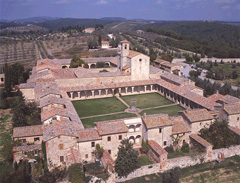
Background

The European Pain School (EPS), founded at the University of Siena (Italy) in 2002, is the first and still the premier school intended for students working on basic science and clinical topics related to acute and chronic pain. EPS has an interdisciplinary perspective and a distinct research orientation. Beginning with the EPS 2012 cycle EPS was adopted as an educational project of the International Association for the Study of Pain (IASP). Young scientists at the Ph.D. or postdoctoral levels (or equivalent) in all fields of pain science and pain medicine are encouraged to apply.
Mission and Overview
In the past the basic mechanisms of pain and the neural pathways involved were explored through research on animals and human subjects using well defined noxious stimuli and observing neurophysiological, behavioral and subjective sensory responses. This straightforward approach, however, is not sufficient to understand most of the real-life spontaneous and prolonged pain states that occur in human patients and animals. Rather, chronic pain involves complex and nonlinear functioning of neural and extraneural systems resulting in the maintenance of the pain process.
Long known are inflammatory mechanisms that can induce a prolonged pain state mediated by pain-producing substances of multiple origin including the immune system, with cytokines stimulating peripheral nociceptors or neurons of the central somatosensory system. Prolonged and enhanced activation of the central pain system may also be due to failure of inhibitory controls in the CNS, a likely mechanism in neuropathic pain. Control by both GABA and endogenous opioids may be affected, causing persistent pain and allodynia. Altered control may also be mediated by cytokines released from activated astrocytes and microglia in the CNS.
The mammalian pain system shows a clear sexual dimorphism that may depend on hormonal influences during peri- and postnatal nervous system development, among other causes. This sexual dichotomy has consequences for pain expression and for psychosocial and medical consequences of pain in males and females, including e.g. the process of pain chronification. Recognition of this dichotomy is resulting in developments in pain medicine that take gender into account.
The International Association for the Study of Pain (IASP) and its worldwide chapters provide impetus to these and other emerging aspects of pain disease mechanisms, resulting in the advancement of interdisciplinary programs for the ultimate benefit of pain patients. The European Pain School is focused on advancing this new vision among junior investigators interested in basic and clinical research on pain.
Topics
- Views into the brain: a pain matrix/ signature/ fingerprint
- Genetic and epigenetic sources of pain variability
- Social and economic impact of pain
- Sex, gender, gonadal hormones and pain
- “Catastrophizing”: thoughts that amplify pain
- Conditions featuring spontaneous pain
- Pain in the trigeminal region
- Who will develop chronic pain?
- Glia-neuron interactions as pain mechanisms
- Central pathways of pain modulation: inhibition and facilitation
- Situational, cognitive and emotional control of pain
- Placebo and verum analgesia – roles in therapeutic outcome
- Opioids and cannabinoids: links between pain and mood enhancement
- Phantom pain, pain memory and cortical plasticity
- Pain and consciousness
- Plasticity of ionic channels and inhibitory synaptic networks
- How do spontaneous and evoked pain differ?
- The challenge of animal models of spontaneous pain
Faculty
Anna Maria Aloisi, Siena, Italy
Giancarlo Carli, Siena, Italy
Luana Colloca, Baltimore, MD, USA
Beth Darnall, Stanford, CA, USA
Marshall Devor, Jerusalem, Israel
Maria Adele Giamberardino, Chieti, Italy
Sean Mackey, Stanford, CA, USA
William Maixner, Durham, NC, USA
Jeffrey Mogil, Montreal, QC, Canada
Jordi Serra, Barcelona, Spain
Irmgard Tegeder, Frankfurt, Germany
Manfred Zimmermann, Heidelberg, Germany
Contacts
Local Organisation
Prof. Anna Maria Aloisi
Management of the School
 +39 0577 234103
+39 0577 234103
 +39 0577 234037
+39 0577 234037
 annamaria.aloisi@unisi.it
annamaria.aloisi@unisi.it
Web support services
Azuleon .:meetings:.
 EPS.2016@azuleon.org
EPS.2016@azuleon.org
This year's photo gallery is available HERE.
Applications
14 December 2015
to
16 February 2016
![]() New deadline
New deadline ![]()
Other
important dates
Notification of selection
20 March 2016
Deadline for attendance confirmation
1 April 2016
Deadline for payment
28 April 2016
School Board
Anna Maria Aloisi
Giancarlo Carli
Marshall Devor
Jordi Serra
Manfred Zimmermann
Previous Schools
EPS 2015
EPS 2014
EPS 2013
EPS 2012
EPS 2011
EPS 2010
EPS 2009
EPS 2008
EPS 2007
EPS 2006
EPS 2005
EPS 2003




